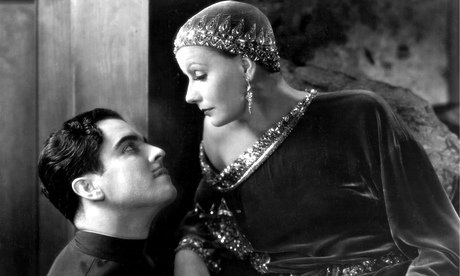
Mata Hari (1931)
Director: George Fitzmaurice
Entertainment grade: B+
History grade: B+
Mata Hari (real name Margaretha Zelle) was an exotic dancer in Paris during the first world war. She was accused of espionage and was executed by firing squad in October 1917.
International relations
It is 1917. Russian aviator Alexis Rosanoff (Ramon Novarro) has an amusing moustache and a strong Mexican accent. This must be very early in 1917: Russia was in turmoil that year, with a revolution in February and the tsar's abdication in March. Fortunately, no sign of that here. Rosanoff is taken by imperial Russian general Serge Shubin (Lionel Barrymore) to see the celebrated Mata Hari dance. In real life, he'd have been disappointed: her final performance was in March 1915.
Performance
"Shiva, I dance for you tonight," intones Mata Hari (Greta Garbo) to a six-armed statue of the Hindu god. She commences something billed as a "sacred dance of Indonesia" that consists of some awkward writhing around in sequins and veils. Rosanoff is bewitched. The real Margaretha Zelle went to Indonesia as a 20-year-old with her much older husband. Her marriage broke up after she returned to her native Netherlands in 1902. She went to Paris and reinvented herself as "a native of Java", debuting at a salon in 1905. According to a British magazine's report of that appearance, she did indeed dance in front of a statue of Shiva, with "authentic Eastern head-dress [and] breast plate of similar workmanship", twirling multicoloured veils. As does Garbo, in this pre-Hays Code film, Zelle usually ended up starkers.
Marriage
Mata Hari is swarmed by fans. "Do you know she married a Dutchman?" says one woman cheerfully to her husband. "He used to beat her!" Perhaps not the tone we might employ to make that remark now, but this is another nod towards historical accuracy. Zelle met her husband, Rudolph MacLeod, through a personal ad he had placed in a newspaper. Their marriage was a disaster, producing two children who ailed and died young (possibly owing to congenital syphilis contracted from their father). MacLeod drank heavily and detested his pretty young wife, writing to a friend during an epidemic of disease in Indonesia that he wished it would "free me from this creature" – ie, kill her.
War
In the film, Mata Hari moves between two fictional men: General Shubin and German spymaster Andriani (Lewis Stone). Andriani is furious with a German captain who has served as his technical expert, and who assured him that the "new weapon called a tank" was impractical. "Captain, those 'impractical' tanks went into action in the Somme yesterday, costing your country 20km of front and 18,000 casualties," he says. Tanks were first used at the Somme on 15 September 1916 , so this is rather slow of him. The film should probably just have set itself in 1916, but presumably didn't want to break the dramatic tension before the inevitably tragic October 1917 ending – so it's best if you just pretend not to notice this, or that some stuff other than loyal tsarism might have been happening in Russia by October 1917.
Espionage
The real Zelle had scores of well-connected lovers, including a French minister for war and a German military attaché. She did try to assist the French secret service through Georges Ladoux, the head of counterespionage – to whom the film's treacherous Inspector Dubois is a rough counterpart. There is scant evidence she was really an important spy, though, or working for the Germans: as even the prosecutor at her trial would admit, "there was not enough evidence [against her] to whip a cat".
Romance
Rosanoff tries to seduce Mata Hari. "I love you as one adores sacred things," he says. "What sacred things?" she replies. He lists them: "God. Country. Honour. You." "I come last?" she snaps back. She can't help falling for him, though, perhaps because of his amusing moustache and strong Mexican accent, or because he is so very sweet and young and stupid. In real life, Zelle had a hot young Russian lover called Captain Vladimir de Masloff, whom she protected just as Mata Hari tries to protect Rosanoff in the film. He was, the real Zelle told her interrogators, "the man I love the most in all the world", and she had certainly tried enough of them to know.
Verdict
Garbo is deliciously watchable in this fictionalised but nonetheless well-researched biopic.

